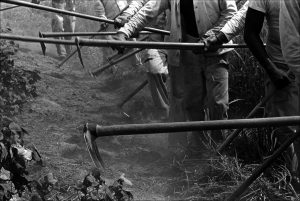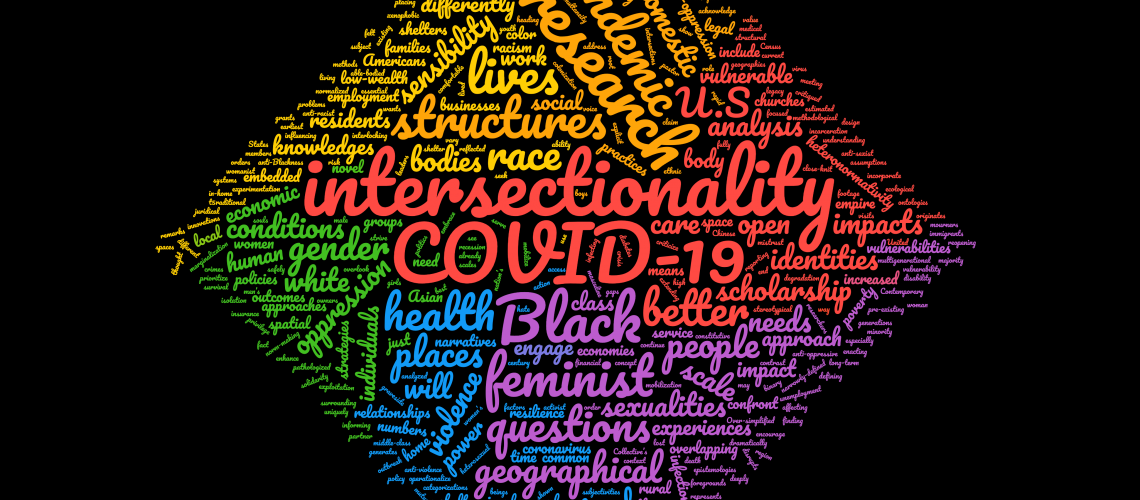Guest Post By Carrie Chennault, 2020-2021 Sustainability Leadership Fellow and Postdoctoral Fellow in the Department of Statistics

Legal scholar and critical race theorist Kimberlé Crenshaw is well-known for advancing the concept of intersectionality beginning in the 1980s-90s, which built upon generations of Black feminist thought and arose out of the lived experiences of Black women in the United States.[i]
Terminology: Intersectionality concerns the “overlapping structures of subordination”that impact certain groups in society.[ii] An intersectional framework draws attention to the ways that power operates through multiple, interlocking forms of oppression, including racism, heteropatriarchy, capitalism, and colonialism.[iii]
Crenshaw foregrounds intersectional analysis in the design of policy, based on the understanding that “meeting the concerns of the most vulnerable would also address the wants of those with fewer needs.”[iv] What sustainability challenges and policy solutions can be revealed through an intersectional lens, from making the concerns of those most marginalized the basis for creating sustainable futures?
Why should we all care about intersectionality? Listen to the Intersectionality Matters! podcast, hosted by Kimberlé Crenshaw. Episode 9 “Under the Blacklight: The Intersectional Vulnerabilities that COVID Lays Bare” frames the discussion of intersectionality within the early days of the pandemic.
In this blog post, I’d like to think with intersectionality to reconsider a timely, real-world example: incarcerated farming and food production in the midst of COVID-19. The CSU School of Global Environmental Sustainability (SoGES) identifies food security as one of its six areas of sustainability research, and the global COVID-19 pandemic has brought even greater attention to challenges in the food system.
What do we know? Since the onset of the pandemic, scientific research and media coverage have pointed to the disproportionate impact of the pandemic on food system workers, especially in meatpacking plants, food processing facilities, and at farms. For example, FERN, the Food & Environment Reporting Network, has tracked data on food system COVID-19 outbreaks in the United States (see inset below). Non-profit think tanks like Food First also have provided a forum for “essential” food and farm laborers—who are disproportionately impacted by the pandemic and, disproportionately, are BIPOC (Black, Indigenous, and People of Color) and/or immigrants—to share their stories and advocate for change.
FERN: Mapping Covid-19 outbreaks in the food system
One food systems topic garnering far less visibility is that of people who are marginalized at the intersections of food systems and systems of mass incarceration. How are they particularly impacted during the pandemic? We do know that prisons are sites of some of the biggest outbreaks in the US and globally, with descriptions of the perpetual danger faced by incarcerated individuals who are unable to socially distance, have had neither consistent nor full access to sanitation and personal protective equipment, have insufficient access to healthcare, and are already in far worse health than the general population.[v] We also know that prisons are spaces where people of color are incarcerated disproportionately compared to white people, and that prison gerrymandering further exacerbates racial injustices faced by those who are incarcerated.
A few organizations, such as PEN America with their Works of Justice rapid-response series Temperature Check: COVID-19 Behind Bars, are featuring the voices and stories of incarcerated individuals during the pandemic. Thinking at the intersections of food labor and carceral labor in particular, however, we know even less about the pandemic-related experiences and outcomes of incarcerated individuals who are workers at farms, meatpacking plants, and food processing facilities.

Although media accounts are few in number—and I know of no academic publications to date—I’d like to share one story that is available. The New Yorker reported a news story on June 15, 2020 about the experiences of the “Hoe Squad” farm workers at the Cummins Unit throughout the early months of the pandemic. The Cummins Unit, located in Arkansas, was originally built to incarcerate Black men. Arkansas, like the US in general, still disproportionately houses Black and other BIPOC individuals. Like state prisons across the US, the Cummins Unit subjects its incarcerated population to exploitative prison farm and food system labor. The New Yorker report describes the harrowing conditions and deadly spread of the virus throughout the Cummins Unit in early Spring 2020: deteriorating and inhumane meals fed to inmates, inadequate protections and deception about the virus as both staff and inmates grew increasingly ill and died, and how inmates were disciplined for refusing to go to work on the farm as infections were first spreading.
The “Hoe Squad” eventually was discontinued during the height of the spread in early spring, only to be resumed again in May. One incarcerated farmworker reported being threatened by staff for refusing to go back to work on the farm. The New Yorker report features excerpts of interviews with several incarcerated individuals at Cummins Unit, including Qadir, who works as a clerk in the prison’s kitchen. In the article, Qadir depicts how oppression occurs at the intersectionality of food systems work and a prison work, employing whatever strategies are available to nourish their bodies. From the report:
[Qadir] broke down the conditions of the average prisoner. “We want [officers who were new to the job] to understand that we have been working for this prison for eight hours a day, every year, for free,” he said. If an inmate on the Hoe Squad takes a cucumber from the farm—the inmates grow them, but they can go for years without tasting one—what’s the harm in letting the man eat one fresh vegetable? Qadir said, “Some go by the book, some turn a blind eye, and some even feed us themselves.”
In a US prison system where incarcerated farm and food laborers grow food sometimes for consumption but often for sale—for the nourishment of the public and profit of the state—these workers simultaneously face: overcrowded confinement, lack of adequate food and nutrition as a pre-existing health condition, far worse food and medical care provided during times of crisis and lockdown, laboring for free while being compelled by discipline, and sentences of severe illness and death during the pandemic—all while at the mercy of staff and state.
This blog post only begins to touch upon the surface in thinking through the injustices—the unsustainability—of food systems at the intersections of food labor and carceral labor. In advocating that we as sustainability scientists employ the concept of intersectionality, I urge you to consider more broadly: what can a greater understanding of the interlocking oppressions, life experiences, and outcomes of “essential” food system workers, in and outside prisons, tell us about what a sustainable future should look like?
[i] Kimberlé Crenshaw, “Demarginalizing the Intersection of Race and Sex: A Black Feminist Critique of Antidiscrimination Doctrine, Feminist Theory and Antiracist Politics,” University of Chicago Legal Forum, no. 1 (1989): 139–67
[ii] Sumi Cho, Kimberlé Williams Crenshaw, and Leslie McCall, “Toward a Field of Intersectionality Studies: Theory, Applications, and Praxis,” Signs: Journal of Women in Culture and Society 38, no. 4 (2013): 797; Kimberlé Crenshaw, “Mapping the Margins: Intersectionality, Identity Politics, and Violence Against Women of Color,” Stanford Law Review 43, no. 6 (1991): 1241–1299.
[iii] LaToya Eaves and Karen Falconer Al-Hindi, “Intersectional Geographies and COVID-19,” Dialogues in Human Geography 10, no.2 (2020): 132–136; Sharlene Mollett and Caroline Faria, “The Spatialities of Intersectional Thinking: Fashioning Feminist Geographic Futures,” Gender, Place & Culture 25, no. 4 (2018): 565–577.
[iv] Eaves and Falconer Al-Hindi, “Intersectional Geographies,” 133.
[v] Elizabeth A. Bradshaw “Do Prisoners’ Lives Matter? Examining the Intersection of Punitive Policies, Racial Disparities, and COVID-19 as State Organized Race Crime,” State Crime Journal 10, no. 1 (2021) : 16–44; Talha Burki, “Prisons are ‘In No Way Equipped’ to Deal with COVID-19,” Lancet 395, no. 10234 (2020) : 1411–1412; Brendan Saloner, Kalind Parish, and Julie A. Ward “COVID-19 Cases and Deaths in Federal and State Prisons,” JAMA 324, no. 6 (2020): 602–603.






